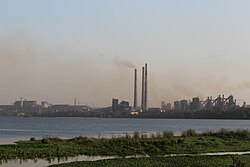Bokaro Steel Plant: Difference between revisions
>Doprendek (added Category:Indian companies established in 1964 using HotCat) |
Hexatron93 (talk | contribs) No edit summary |
||
| Line 9: | Line 9: | ||
| name = Bokaro Steel Plant | | name = Bokaro Steel Plant | ||
| logo = | | logo = | ||
| image = | | image = Bokaro_Steel_Plant_.jpg | ||
| type = [[Government-owned corporation|State-owned enterprise]]<br />public company | | type = [[Government-owned corporation|State-owned enterprise]]<br />public company | ||
|traded_as={{NSE|SAIL}} | |traded_as={{NSE|SAIL}} | ||
Revision as of 15:41, 17 May 2023
This article has multiple issues. Please help improve it or discuss these issues on the talk page. (Learn how and when to remove these template messages)
|
 | |
| Traded as | NSE: SAIL |
|---|---|
| Industry | Steel |
| Founded | 1964 |
| Headquarters | Bokaro, Jharkhand, India |
| Products | Hot Rolled & Cold Rolled |
Bokaro Steel Plant (BSL) is located in the Bokaro district of Jharkhand. It is the fourth integrated public sector steel plant in India built with Soviet help. It was incorporated as a limited company in 1964.[1] It was later merged with the state-owned Steel Authority of India Limited (SAIL).[2]
Currently it houses five blast furnaces with a total capacity to produce 5.8 MT of liquid steel.[3] The plant is undergoing a mass modernisation drive after which its output capacity is expected to cross 10 MT.
An upgrade of the plant was also done in the 1990s in its steel refining units and continuous casting machines. The plant has recently taken expansion plan along with Korean Steel Company, Pohang Iron and Steel Company (POSCO)[1] Initially, about 64 moujas (a mouja may have several village units) had been acquired for the plant. Of the total land acquired, only 7,765 ha was used to set up the steel plant. The rest has been given by SAIL to the private parties without government’s approval.
The plant's yearly profit stood at ₹11.2 billion (US$160 million) for the financial year 2003–04 and has increased every year since then reaching to 84.26 billion INR in the financial year 2007–08.
Products
Bokaro Steel Plant is designed to produce a wide range of products:
- Hot rolled coils
- Hot rolled plates
- Hot rolled sheets
- Cold rolled coils (CRM)
- Cold rolled sheets
- Tin mill black plates
- Galvanised plain and corrugated sheets
- Oxygen gas
- Hydrogen gas
- Coke oven byproducts
References
- ↑ Nirmal Sengupta (1979). Destitutes and Development: A Study of the Bauri Community in the Bokaro Region. Concept Publishing Company. pp. 25–. GGKEY:73SPC2220UQ.
- ↑ Steel Authority Of India Limited
- ↑ "BOKARO STEEL PLANT - PRODUCT BASKET".
Further reading
- Sutinder Bhatia (1 January 1991). Bokaro steel plant: some economic aspects. Popular Prakashan. ISBN 978-81-7154-540-7.
- Padma Desai (1972). The Bokaro steel plant: a study of Soviet economic assistance. North-Holland Pub. Co. ISBN 978-0-444-10388-8.
